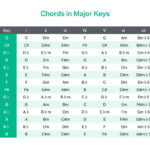Learning guitar chords can feel like deciphering a secret language, especially when you’re navigating a world often designed for right-handed players. If you’re a left-handed guitarist just starting your musical journey, you might have noticed that most chord charts seem backwards. But don’t worry, playing guitar left-handed is absolutely achievable, and mastering chords is the first exciting step. This guide is specifically crafted for you, the left-handed beginner, focusing on the essential “Left Handed Guitar Chords” you need to start playing your favorite songs today. We’ll break down why these chords are crucial and provide easy-to-read, left-handed chord diagrams to get your fingers in the right position.
Why Learn These Chords First? The Beginner’s Toolkit
There are compelling reasons why starting with a specific set of chords is beneficial for any beginner guitarist, and especially helpful when you are focusing on “left handed guitar chords”. These initial chords act as the building blocks for your guitar playing foundation.
-
Simplicity and Open Position Mastery: The first chords you should tackle are designed for the “open position,” also known as “cowboy chords.” These chords are played within the first few frets of the guitar neck and utilize open strings. This means you don’t need to fret every string, making them significantly easier to form, especially for beginners still developing finger strength and dexterity. For example, the E minor chord only requires fretting two strings, while the rest ring open – a great introduction to chord shapes.
-
CAGED System Foundation: As you progress, you’ll discover the brilliance of the CAGED system. Many of these beginner-friendly chord shapes become movable barre chords, allowing you to play different chords up and down the guitar neck. Learning these open position shapes now builds crucial muscle memory. The acronym CAGED (C, A, G, E, D) isn’t just a random word; it represents these fundamental chord shapes that unlock fretboard navigation and chord versatility.
-
Unlock Countless Songs: This set of chords isn’t just easy to learn; it’s incredibly practical. These are some of the most frequently used chords in popular music across genres. By mastering these “left handed guitar chords,” you’ll quickly be able to play a vast repertoire of songs, practice common chord progressions, and develop your strumming techniques. Learning these chords first provides immediate gratification and keeps you motivated on your guitar journey.
So, are you ready to dive in? Below are the essential beginner “left handed guitar chords,” complete with diagrams and simple instructions to get you playing quickly.
Essential Left Handed Guitar Chords for Beginners
E Minor (Em)
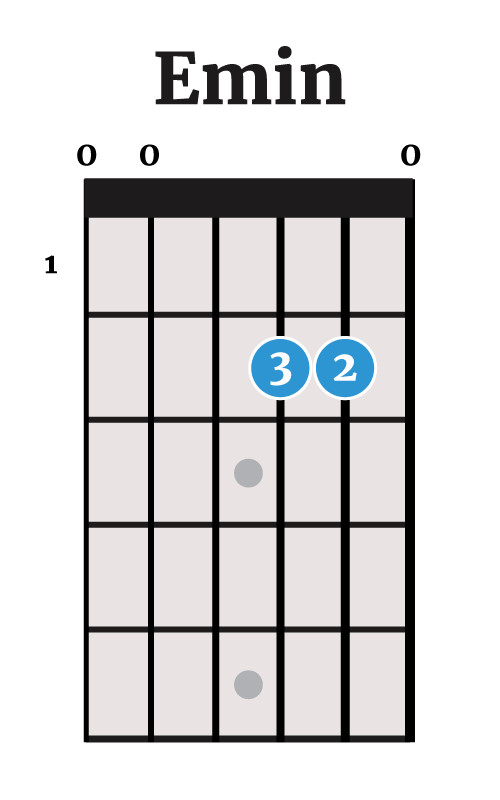 Left-Handed E Minor Chord (Open Position)
Left-Handed E Minor Chord (Open Position)
To play the open position E minor chord as a left-handed player, place your second finger on the second fret of the A string (that’s the 5th string from the thinnest, remember bass strings are on the right in these diagrams). Then, use your third finger to fret the second fret of the D string (the 4th string). Make sure to strum all six strings for this chord.
The E minor chord is made up of the notes E (the root), G (the minor third), and B (the fifth).
Want to delve deeper into the E minor chord? You can explore more about its theory and discover various voicings here.
E Major (E)
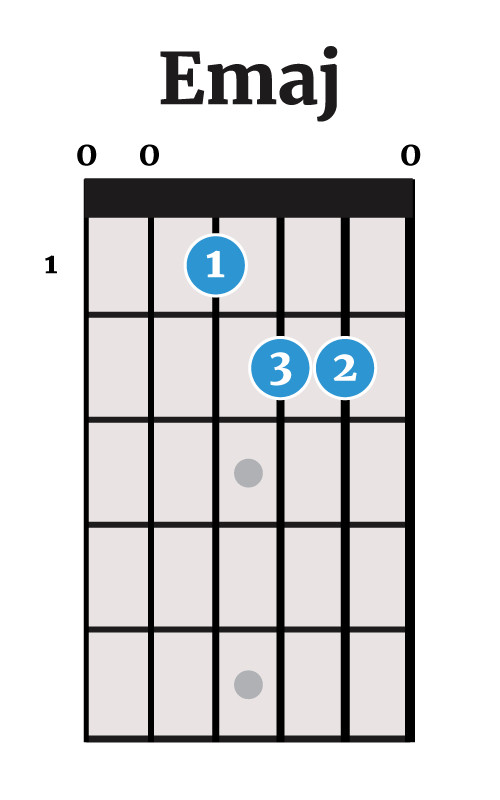 Left-Handed E Major Chord (Open Position)
Left-Handed E Major Chord (Open Position)
Transforming the E minor into an E Major chord is surprisingly simple – just add one finger! Place your first finger on the first fret of the G string (the 3rd string). You might have wondered why we didn’t use the first finger in the E minor chord diagram, and this is why – versatility!
The E Major chord contains the notes E (Root), G# (major third), and B (the fifth).
To further your understanding, you can learn more about the theory behind the E Major chord and explore different ways to play it here.
A Major (A)
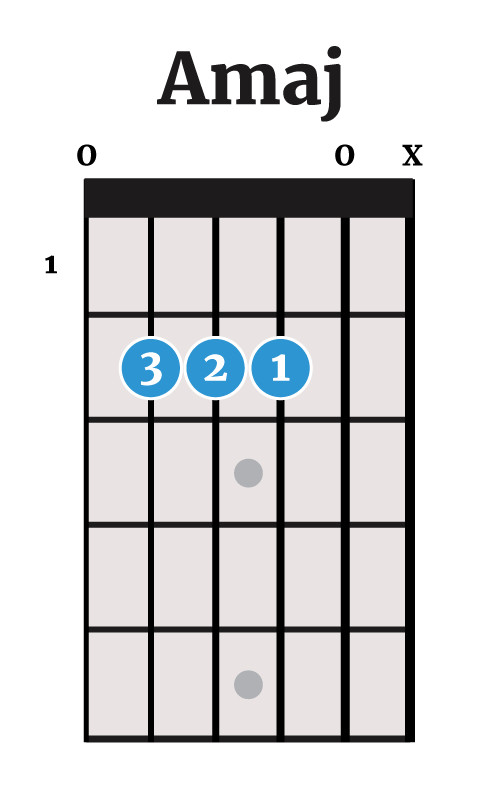 Left-Handed A Major Chord (Open Position)
Left-Handed A Major Chord (Open Position)
For the A Major chord, you’ll use three fingers on the second fret. Place your second finger on the second fret of the D string (4th string), your third finger on the second fret of the G string (3rd string), and your fourth finger on the second fret of the B string (2nd string).
The A Major chord is composed of the notes A (Root), C# (major third), and E (the fifth).
Expand your knowledge of the A Major chord by reading more about its music theory and exploring alternative voicings here.
A Minor (Am)
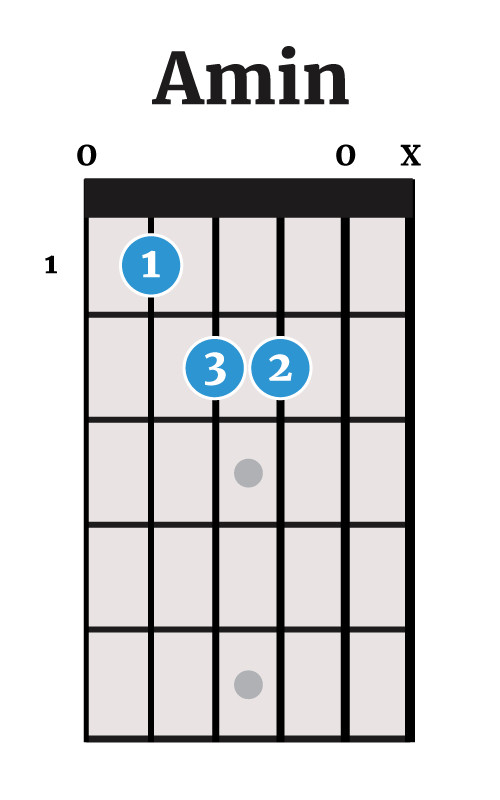 Left-Handed A Minor Chord (Open Position)
Left-Handed A Minor Chord (Open Position)
Switching from A Major to A Minor is another easy adjustment. Simply lift your fourth finger and place your first finger on the first fret of the B string (2nd string). Again, you can see why we didn’t use the first finger for the A Major chord on the D string – it allows for this smooth transition to A minor.
The A minor chord includes the notes A (Root), C (minor third), and E (the fifth).
Deepen your understanding of the A minor chord by exploring its theory and different ways to play it on this page.
D Major (D)
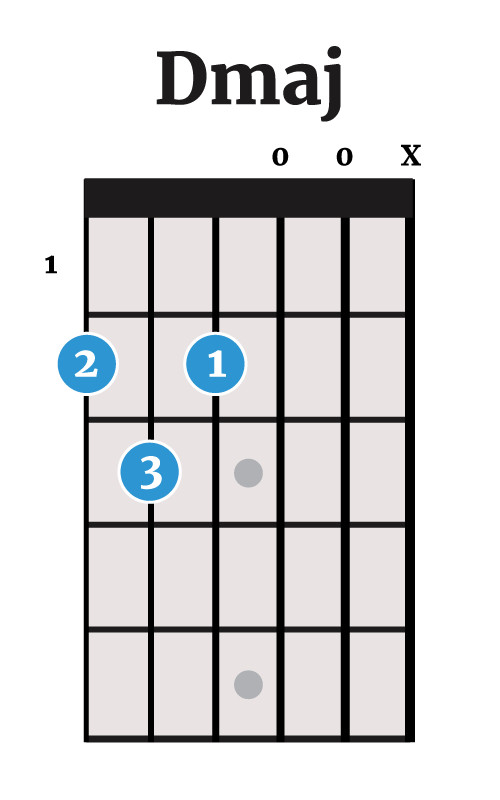 D Major Chord – Left-Handed
D Major Chord – Left-Handed
The D Major chord is a staple in countless songs. To play it, place your first finger on the 2nd fret of the G string (3rd string). Then, use your third finger on the 3rd fret of the B string (2nd string) and your second finger on the 2nd fret of the high E string (1st string). Note the ‘x’ symbols above the low E and A strings in the diagram – these strings are not played in a standard D Major chord.
The D Major chord consists of the notes D (Root), F# (major third), and A (the fifth).
Further your D Major knowledge by reading about its theory and exploring various chord voicings here.
D Minor (Dm)
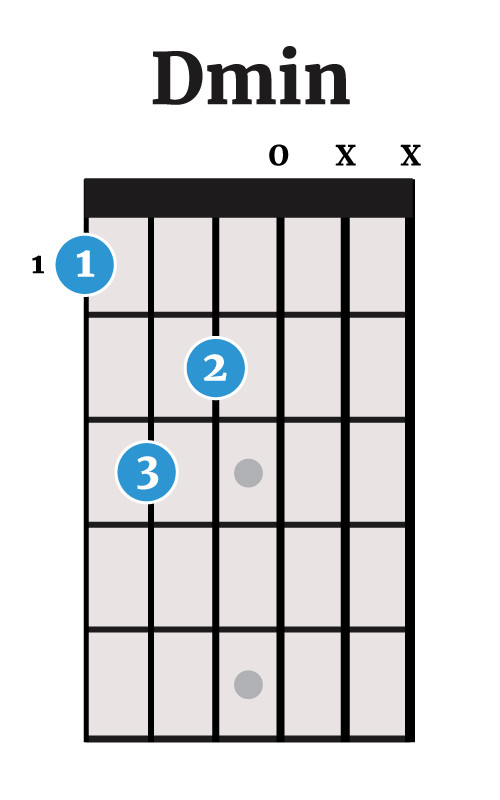 Left-Handed D Minor Chord (Open Position)
Left-Handed D Minor Chord (Open Position)
For the D minor chord, we’ll use a slightly different fingering than D Major to achieve the minor sound. Place your first finger on the first fret of the high E string (1st string), your second finger on the second fret of the G string (3rd string), and your third finger on the 3rd fret of the B string (2nd string).
The D minor chord is made up of the notes D (Root), F (minor third), and A (the fifth).
Expand your D minor chord skills by learning more about its theory and different ways to play it here.
C Major (C)
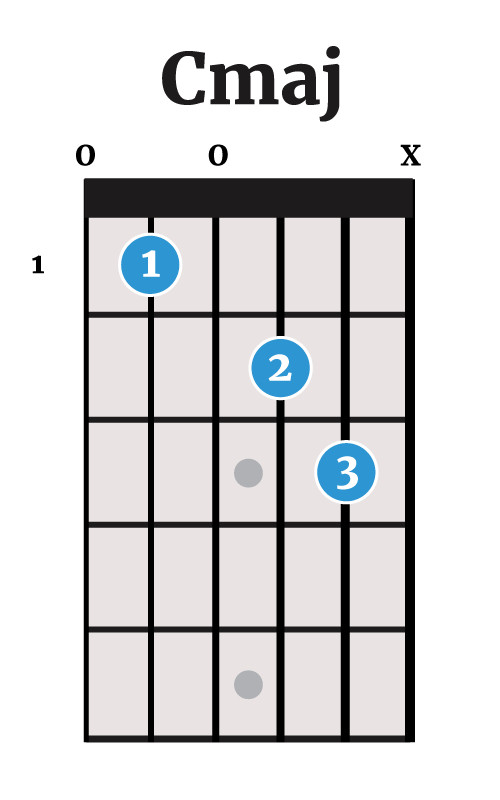 Left-Handed C Major Chord (Open Position)
Left-Handed C Major Chord (Open Position)
C Major is another essential chord that appears frequently in popular music. To play C Major, fret the first fret of the B string (2nd string) with your first finger. Then, fret the second fret of the D string (4th string) using your second finger, and place your third finger on the third fret of the A string (5th string). Be sure to avoid strumming the low E string (6th string) when playing C Major, as E is not part of the C Major chord.
The C Major chord contains the notes C (Root), E (major third), and G (the fifth).
Deepen your C Major chord knowledge by exploring its theory and different voicings on this page.
G Major (G)
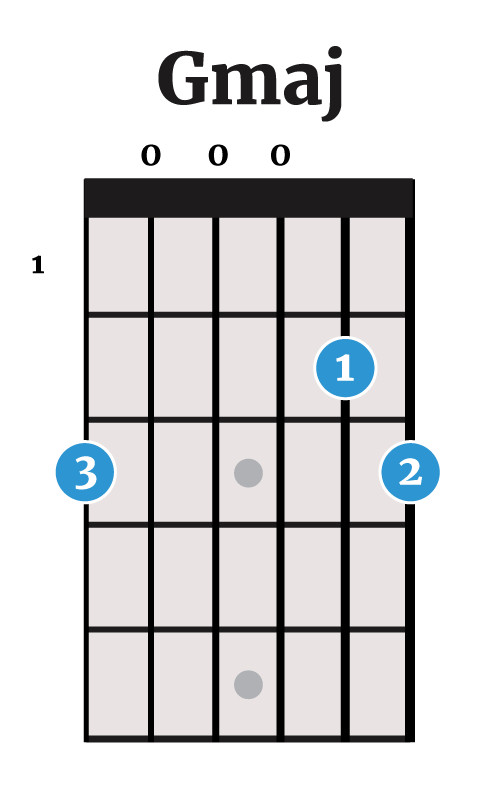 Left-Handed G Major Chord (Open Position)
Left-Handed G Major Chord (Open Position)
Our final must-know beginner chord is G Major. It’s famously the very first chord in “Knockin’ on Heaven’s Door,” a song you’re likely to encounter early in your guitar journey.
To play G Major, fret the third fret of the low E string (6th string) with your second finger. Place your first finger on the second fret of the A string (5th string), and your third finger on the third fret of the high E string (1st string). Remember to strum all six strings for the G Major chord.
The G Major chord is composed of the notes G (Root), B (major third), and D (the fifth).
Enhance your understanding of the G Major chord by learning more about its theory and various ways to play it here.
Start Playing Left Handed Guitar Chords Today!
Congratulations on taking the first step towards mastering “left handed guitar chords”! These essential chords are your starting point for a lifetime of musical enjoyment. Chord charts are powerful tools, and becoming familiar with both standard and left-handed versions will significantly benefit your learning. Practice these chords regularly, and soon you’ll be strumming along to your favorite songs and exploring the vast world of guitar music. Keep practicing, and happy playing!

